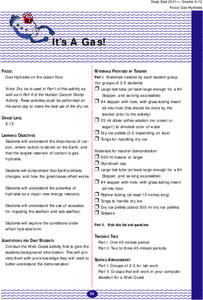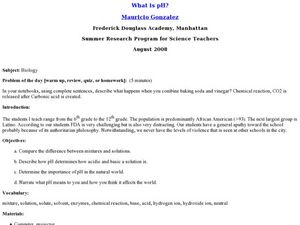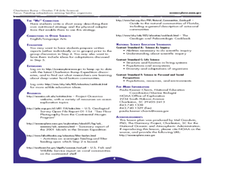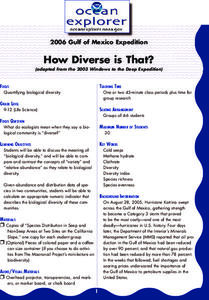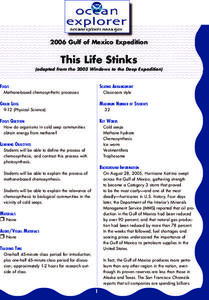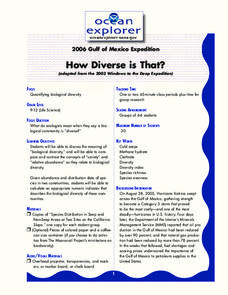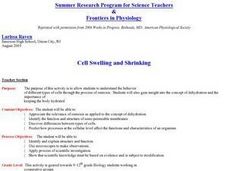Curated OER
Laboratory: Hydrated Salts
In this hydrated salt worksheet, students answer questions after completing a lab experiment using a hydrated salt. The calculate the empirical formula for the hydrate, they name the hydrate and they determine the mass of the water in...
Curated OER
Water/Hydration
Students develop an understanding of the role water has in the body and the importance of getting enough water each day. Through the lesson, students recognize the risks and signs of dehydration. Also, they identify foods with high...
Outdoor Learning Center
Outdoor Survival
Which of the following can you survive without for the longest time: water, food, or a positive mental attitude? The answer may surprise you. Guide learners of all ages through games, activities, and discussions about surviving in the...
Baylor College
Water in Your Body
Do you know how much water you have had in the last 24 hours? Do you know how much your body needs? In this hands-on activity, your class members will estimate how much water our bodies lose each day by filling and emptying one-liter...
NOAA
Importance of Deep-Sea Ecosystems – How Diverse is That?
When judging diversity of an ecosystem, both species evenness and species richness must contribute. After a discussion of diversity and a guided example using the Shannon-Weaver function, scholars use the same function on two other...
Curated OER
It Is the Little Things That Count
Third graders are introduced to the importance of warm-ups, stretching, hydration and cool-downs in exercise. They perform these activities and discuss any observations.
Curated OER
Harvesting Hope: The Story of Cesar Chavez
Learners identify productive resources that are important to migrant workers. For this lesson on resources, students give examples of natural resources, human resources and capital resources that apply to migrant workers. This lesson has...
Curated OER
Chemosynthesis for the Classroom
Explorers set up Windogradsky columns with local mud so that they can culture microorganisms. After three and six weeks they make observations of the mud and the organisms growing in it. In this way they observe succession and relate...
Curated OER
Introductory Lesson on How pH Levels are Determined
Students explore pH levels of different substances. In this lesson about pH, students work together in three to four groups to test substances. moving between three different stations performing tests on the substances to determine...
Curated OER
It's a Gas!
High schoolers explore the conditions under which hydrates form. They use the Internet to access information and conduct experiments to examine how the greenhouse effect works.
Curated OER
What is pH?
Pupils describe pH and the importance of it in the natural world. In this Biology activity students compare the pH of different mixtures.
Curated OER
This Life Stinks
Learners study how organisms that live in cold seep communities get energy from methane. In this organism lesson students write a brief report and identify oxidation reduction reactions and explain if these are dependent of...
Curated OER
Concrete Lesson Plan
Young scholars describe the difference between cement and concrete. In this technology instructional activity, students explain the mixing process of concrete. They discuss its importance in the modern world.
Curated OER
How Am I Supposed to Eat THAT?
Students explain nutritional strategies of benthic organisms.They describe nutritional strategies of benthic organisms and describe these physical characteristics.
Curated OER
Fabulous Felines
Students explore basic needs through discovering that pets and people need very similar things. They will play matching games, sing songs, read books, and discuss the needs of people and animals.
Curated OER
Life is Weird
Separate your science class into small groups and assign each a specific deep-sea organism to research. The class will learn about all of the organisms as each group presents their assigned animal. Following their presentations, you can...
Curated OER
How Diverse is That?
After reviewing biodiversity, learners work in small groups to analyze actual species distribution data. They learn to calculate the Shannon-Weaver diversity index for different communities. Though not particularly engaging, the content...
Curated OER
This Life Stinks
Chemosynthetic communities of cold seep areas are considered in this lesson. Working in collaborative groups, marine biology or oceanography learners research and prepare a report about oxidation-reduction reactions involved with...
Curated OER
You Are What You Eat (Grades 5-8)
Students gain an enhanced understanding of the relationship between proper nutrition and good health. Through use of video, hands-on activities and interaction, students measure energy in food, and recognize sources of vitamins and...
Curated OER
How Diverse is That?
Students discuss biological diversity in ocean communities. In this diversity instructional activity, students examine the variety of organisms compared to relative abundance. They will write an analysis and discuss their findings with...
Curated OER
Cell Swelling and Shrinking
Young scholars examine the concept of osmosis in relation to dehydration. They identify the function and structure of semi-permable membranes. They predict how certain processes can affect the characteristics of an organism.
Curated OER
Visualizing the Greenhouse Effect and Global Warming
Students discover the differences between global warming and the greenhouse effect through hands-on classroom experiences. They use a 2-D globe and picture cards to identify the causes of both. Students visualize the human influence on...
Curated OER
Chemistry And The Nitrogen Cycle
Students investigate the factors that compose the nitrogen cycle. The harmful effects of acid rain and ozone depletion are also discussed in the lesson. Students define the nutrient that is often limiting to plant growth through...
Curated OER
Easy as Pi
Students examine structural features. In this life science lesson students complete an activity and quantify the impact of various modifications.











